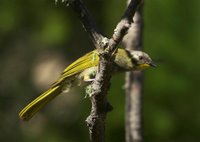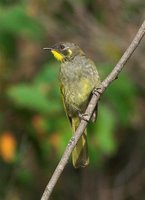On The Move
 It's about this time of year that the Yellow-throated Honeyeaters start to move. This move is largely a 'dispersal', often moving into urban areas. Over the past 20 years or so I've recorded them appearing in my garden early in February, mostly in ones and twos. This year they started appearing in early January. Exactly what this may signify, I can only guess at. In the Meehan R
It's about this time of year that the Yellow-throated Honeyeaters start to move. This move is largely a 'dispersal', often moving into urban areas. Over the past 20 years or so I've recorded them appearing in my garden early in February, mostly in ones and twos. This year they started appearing in early January. Exactly what this may signify, I can only guess at. In the Meehan R ange at the moment they are particularly abundant, gleaning insects from leaves and under bark. They are also one of the numerous species bathing. I've noted while banding, that they are usually in moult at this time, and often have pieces of feather sheathing on their plumage, which may account for the frequent bathing. One February, my son, Matthew and I, caught and banded over 50 mainly juvenile birds in one net, in less than one (frantic) hour. Which for a species not usually (ever?) found in flocks, was somewhat surprising. For an endemic species, I suspect we know rather less than we should about Yellowthroats.
ange at the moment they are particularly abundant, gleaning insects from leaves and under bark. They are also one of the numerous species bathing. I've noted while banding, that they are usually in moult at this time, and often have pieces of feather sheathing on their plumage, which may account for the frequent bathing. One February, my son, Matthew and I, caught and banded over 50 mainly juvenile birds in one net, in less than one (frantic) hour. Which for a species not usually (ever?) found in flocks, was somewhat surprising. For an endemic species, I suspect we know rather less than we should about Yellowthroats.
 It's about this time of year that the Yellow-throated Honeyeaters start to move. This move is largely a 'dispersal', often moving into urban areas. Over the past 20 years or so I've recorded them appearing in my garden early in February, mostly in ones and twos. This year they started appearing in early January. Exactly what this may signify, I can only guess at. In the Meehan R
It's about this time of year that the Yellow-throated Honeyeaters start to move. This move is largely a 'dispersal', often moving into urban areas. Over the past 20 years or so I've recorded them appearing in my garden early in February, mostly in ones and twos. This year they started appearing in early January. Exactly what this may signify, I can only guess at. In the Meehan R ange at the moment they are particularly abundant, gleaning insects from leaves and under bark. They are also one of the numerous species bathing. I've noted while banding, that they are usually in moult at this time, and often have pieces of feather sheathing on their plumage, which may account for the frequent bathing. One February, my son, Matthew and I, caught and banded over 50 mainly juvenile birds in one net, in less than one (frantic) hour. Which for a species not usually (ever?) found in flocks, was somewhat surprising. For an endemic species, I suspect we know rather less than we should about Yellowthroats.
ange at the moment they are particularly abundant, gleaning insects from leaves and under bark. They are also one of the numerous species bathing. I've noted while banding, that they are usually in moult at this time, and often have pieces of feather sheathing on their plumage, which may account for the frequent bathing. One February, my son, Matthew and I, caught and banded over 50 mainly juvenile birds in one net, in less than one (frantic) hour. Which for a species not usually (ever?) found in flocks, was somewhat surprising. For an endemic species, I suspect we know rather less than we should about Yellowthroats.
3 comments:
I havent yet come across any indepth study on the Yellow Throat, and that is really a shame. they must be one of the best birds to watch because they stick around and try to sus you out. While bushwalking, they seem to follow for quite a while before disapering. they make quite good company but do tend to chase other brids away, or get harassed themselves by other nesting birds. its good to see them get a mention, especially when Birds Tas has named their news-letter after them.
Agreed, but like most honeyeaters, I find them notoriously difficult to photograph, because they just won't sit still!
I was fortunate photographing these 2 individuals as thay were drawn to the waterhole in the Meehan Range. I also photographed several other species that I'll blog in due course no doubt.
Post a Comment